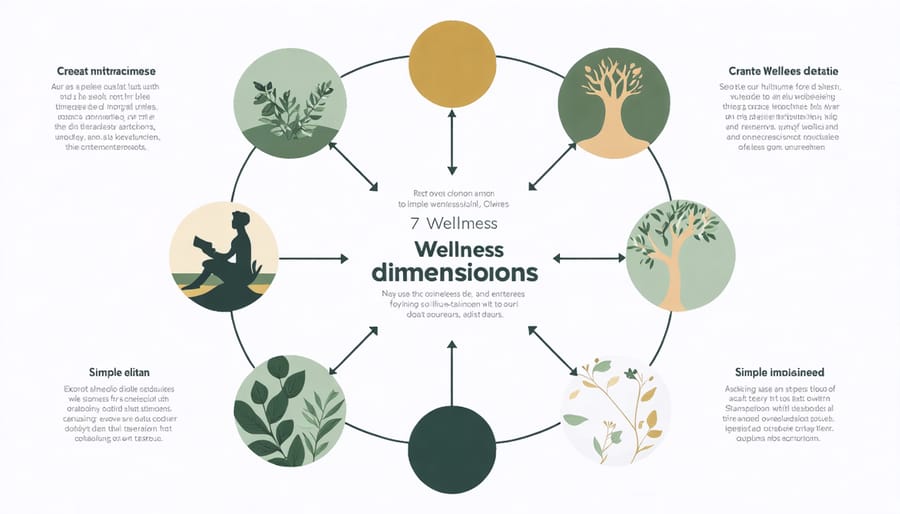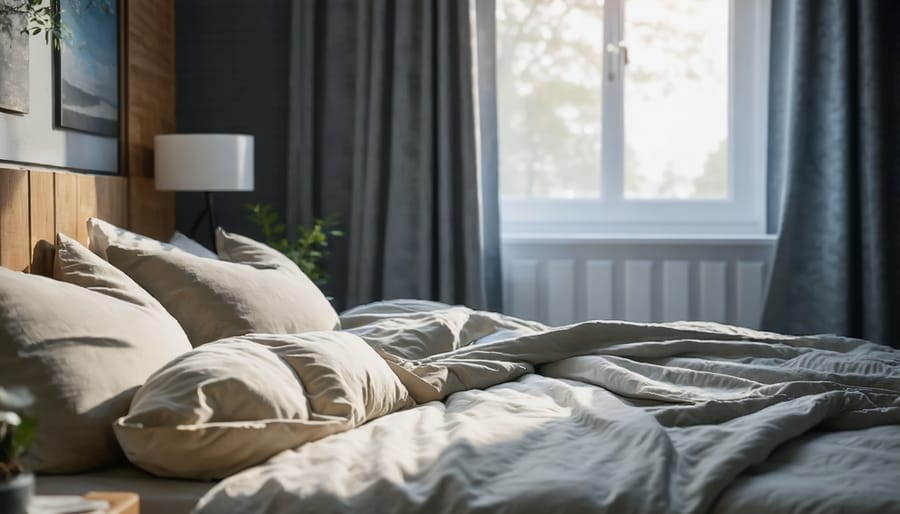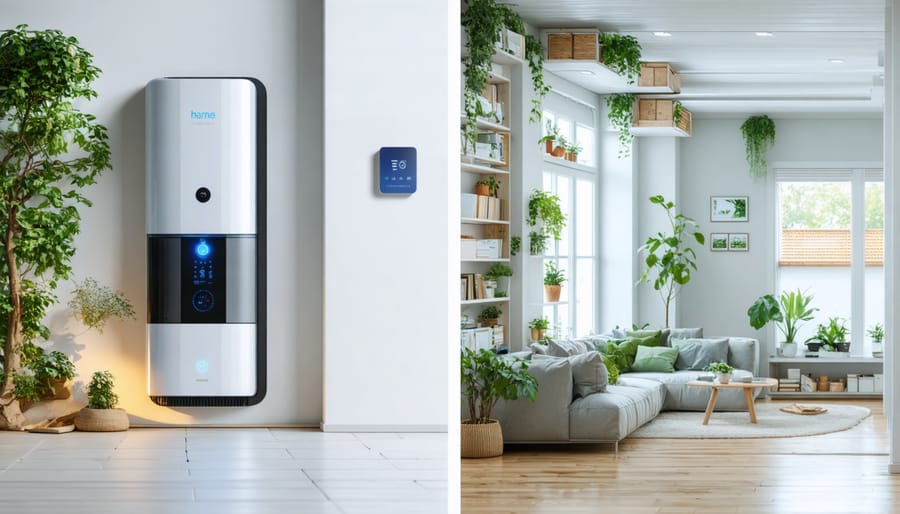Transform your life by understanding and nurturing the seven dimensions of wellness: physical, emotional, intellectual, social, spiritual, environmental, and occupational health. These interconnected aspects form the foundation of a truly balanced and fulfilling lifestyle, extending far beyond traditional notions of health and fitness.
Think of these dimensions as the vital pieces of your personal wellness puzzle. When one area thrives, it naturally elevates the others – just as physical exercise can boost your emotional well-being, or meaningful social connections can enhance your spiritual growth. Modern research shows that people who actively maintain all seven dimensions are 65% more likely to report high life satisfaction and demonstrate greater resilience in challenging times.
Whether you’re just beginning your wellness journey or looking to deepen your existing practices, understanding these seven dimensions provides a comprehensive framework for sustainable self-improvement. This holistic approach acknowledges that true wellness isn’t about perfecting any single aspect of your life – it’s about creating harmony among all the elements that make you whole.
Let’s explore each dimension in detail, complete with practical strategies you can implement today to enhance your overall well-being.

Understanding the Seven Wellness Dimensions in Your Home Environment
Physical Wellness: Temperature Control Fundamentals
Your body works best within a specific temperature range, and maintaining this balance is crucial for your overall wellness. Most people feel most comfortable when their indoor environment stays between 68-72°F (20-22°C), but personal preferences can vary. This sweet spot isn’t just about comfort – it directly impacts your physical health and well-being.
When your space is too warm, you might experience fatigue, dehydration, and difficulty concentrating. Excess heat can also disrupt your sleep patterns and increase stress levels. On the flip side, environments that are too cold can cause muscle tension, reduced circulation, and a weakened immune system.
To maintain optimal temperature control in your living space, consider these practical tips:
– Use programmable thermostats to automatically adjust temperatures throughout the day
– Install proper insulation to maintain consistent temperatures
– Utilize ceiling fans to improve air circulation
– Add humidity control to enhance comfort
– Use natural ventilation when weather permits
– Layer clothing instead of dramatically adjusting thermostat settings
Pay attention to how temperature affects your daily activities. Are you feeling sluggish in the afternoon? Is your sleep quality suffering? These could be signs that your temperature control needs adjustment. Remember that different rooms may require different temperature settings based on their use and occupancy patterns.
Emotional Wellness: Creating Comfort Zones
Temperature plays a crucial role in shaping our emotional well-being, affecting everything from our mood to our stress levels. Just as we carefully consider mood-boosting lighting solutions, maintaining optimal temperatures in different living spaces can significantly impact our emotional comfort.
Research shows that rooms kept between 68-72°F (20-22°C) typically promote the best emotional balance. When spaces are too warm, we might feel sluggish and irritable, while overly cool environments can increase tension and anxiety. The bedroom, in particular, benefits from slightly cooler temperatures around 65°F (18°C) for optimal sleep quality, which directly affects our emotional state the next day.
Creating temperature zones throughout your home allows family members to find their perfect comfort level. Consider using smart thermostats to program different temperatures for various times of day, matching your body’s natural rhythm. Adding simple elements like cozy throws in cooler areas or installing ceiling fans for gentle air circulation can help maintain emotional equilibrium through temperature regulation.
Remember, emotional wellness isn’t just about the temperature itself – it’s about creating an environment where you feel most at peace and in control of your comfort.
Smart Temperature Solutions for Different Living Spaces
Bedroom Comfort: Supporting Quality Sleep
Your bedroom’s temperature plays a crucial role in achieving restful sleep, which is fundamental to your overall wellness. The ideal sleeping temperature ranges between 60-67°F (15-19°C), but personal preference might vary slightly. Creating the perfect sleep environment goes beyond temperature, though – it’s about crafting a complete sanctuary that includes calming sound environments and proper ventilation.
To optimize your bedroom’s comfort, start with these practical steps:
1. Install blackout curtains or shades to regulate both temperature and light
2. Use layered bedding that you can adjust throughout the night
3. Consider a programmable thermostat to maintain consistent temperatures
4. Ensure proper air circulation with a ceiling fan or small room fan
5. Invest in moisture-wicking bedding materials for temperature regulation
Your choice of mattress and pillows also affects temperature regulation. Look for materials with cooling properties like gel-infused memory foam or natural latex. Adding a mattress protector designed for temperature control can enhance comfort without compromising the cooling features of your bedding.
Remember to adjust your bedroom’s temperature about an hour before bedtime, allowing your body to naturally transition into sleep mode. This proactive approach to temperature management can significantly improve your sleep quality and, consequently, your daily wellness.

Living Room Balance: Social and Environmental Wellness
Your living room is more than just a space to watch TV – it’s the heart of your home’s social wellness dimension. Creating a balanced living area that encourages both connection and comfort starts with thoughtful furniture arrangement. Position seating in conversational groupings, ensuring chairs and sofas face each other at comfortable angles that promote eye contact and easy dialogue.
Consider incorporating different seating options to accommodate various social scenarios, from intimate conversations to larger gatherings. A mix of two-person loveseats, comfortable armchairs, and perhaps a few ottomans that can double as extra seating provides flexibility for any social situation.
The environmental aspect of your living room shouldn’t be overlooked either. Incorporate plants to improve air quality and create a connection to nature. Choose materials and textiles that are both sustainable and inviting – think organic cotton throws, bamboo accent pieces, or locally crafted decorative items.
Lighting plays a crucial role in both social and environmental wellness. Layer your lighting with a mix of ambient, task, and accent options. Natural light should be maximized during the day, while warm, adjustable lighting creates an inviting atmosphere for evening gatherings.
Remember to keep the space clutter-free and organized. A tidy environment reduces stress and makes the room more welcoming for both residents and guests. Consider incorporating storage solutions that maintain the room’s aesthetic while keeping essential items within reach.
Home Office Climate: Enhancing Productivity
Creating the perfect temperature in your home office is crucial for maintaining focus and productivity throughout your workday. Studies show that the ideal working temperature falls between 68-72°F (20-22°C), but personal comfort can vary. When combined with an ergonomic home office setup, the right temperature can significantly boost your work performance.
To optimize your office climate, start by assessing your room’s current temperature patterns. Install a smart thermostat to maintain consistent temperatures and monitor humidity levels, which should stay between 30-50%. Consider the position of your desk relative to windows and heating/cooling vents, as direct exposure can create uncomfortable hot or cold spots.
Simple adjustments can make a big difference. Use thermal curtains or blinds to control sunlight and heat gain. Draft excluders under doors and weatherstripping around windows can prevent temperature fluctuations. If you’re dealing with a particularly warm space, a small desk fan can provide personal cooling without affecting your entire home’s temperature.
Remember that your body temperature naturally fluctuates throughout the day. Keep a light sweater or wrap nearby for those moments when you need extra warmth, and stay hydrated to help your body regulate its temperature more effectively. These small but meaningful changes can create a more comfortable and productive workspace while maintaining energy efficiency.

Natural and Technological Solutions for Personal Comfort
Smart Climate Control Systems
Today’s smart climate control systems have revolutionized the way we experience comfort at home. Gone are the days of one-size-fits-all temperature settings; modern technology now allows us to create personalized comfort zones throughout our living spaces.
Smart thermostats learn your preferences and daily routines, automatically adjusting temperatures to optimize both comfort and energy efficiency. Many systems now integrate with smartphone apps, letting you control your home’s climate from anywhere. Imagine warming up your bedroom before bedtime or cooling down your home office before starting your workday, all with a simple tap on your phone.
These intelligent systems go beyond basic temperature control. Advanced features like humidity monitoring, air quality sensors, and zone-based heating and cooling ensure every room maintains ideal conditions. Some systems even track weather patterns and adjust accordingly, helping you stay comfortable while reducing energy costs.
For optimal wellness benefits, consider systems that offer:
– Programmable schedules for different times of day
– Room-by-room temperature control
– Air quality monitoring and filtration
– Voice control integration
– Energy usage reports and optimization suggestions
When selecting a smart climate control system, focus on features that align with your daily routine and wellness goals. The initial investment often pays off through improved comfort, better sleep quality, and reduced energy bills. Remember, the best system is one that works seamlessly with your lifestyle while maintaining your ideal comfort level throughout the day.
Natural Ventilation Strategies
Natural ventilation is one of the most effective and energy-efficient ways to improve indoor air quality and maintain comfortable temperatures in your home. By strategically using windows, doors, and architectural features, you can create natural airflow patterns that help cool your space in summer and retain warmth in winter.
Start by identifying your home’s cross-ventilation potential. Open windows on opposite sides of your house to create a natural breeze pathway. In multi-story homes, take advantage of the stack effect by opening upper-level windows slightly more than lower ones, allowing warm air to naturally rise and escape while drawing in cooler air below.
During summer months, use window treatments strategically. Keep blinds and curtains closed during peak heat hours on sun-facing windows, but open them during cooler evening hours to release trapped heat. Consider installing window awnings or planting deciduous trees that provide shade in summer while allowing beneficial sun exposure in winter.
For winter comfort, let sunshine in through south-facing windows during the day to naturally warm your space. Close all window coverings at sunset to retain this free heat. Weather stripping around windows and doors helps maintain desired temperatures while reducing energy costs.
Remember to adjust these strategies based on your local climate and home’s design. Small changes in how you manage natural airflow can make a significant difference in both comfort and energy efficiency.
Sustainable Comfort Solutions
Creating a comfortable home environment doesn’t have to come at the expense of our planet. By incorporating biophilic design elements and eco-friendly practices, you can maintain optimal thermal comfort while reducing your environmental footprint.
Start with natural ventilation strategies by positioning furniture to maximize air flow and using windows strategically during cooler hours. Install thermal curtains or cellular shades that trap air between layers, providing natural insulation during both hot and cold seasons. Consider adding indoor plants, which not only purify the air but also help regulate humidity levels naturally.
For temperature control, opt for programmable thermostats that adjust automatically based on your daily routine. During summer, use ceiling fans to create a cooling effect without relying heavily on air conditioning. In winter, seal drafts around windows and doors with weather stripping, and add area rugs to insulate bare floors.
Layer your living spaces with sustainable materials like organic cotton throws, wool blankets, and bamboo textiles. These natural fibers help regulate body temperature while being environmentally responsible choices. Position seating areas away from direct sunlight or drafty spots to create comfortable micro-environments within your rooms.
Remember, sustainable comfort isn’t just about temperature – it’s about creating a harmonious living space that supports both your wellbeing and environmental consciousness. Small changes in your home’s setup can lead to significant improvements in comfort while reducing energy consumption.
Seasonal Adaptation Strategies

Winter Wellness Solutions
As winter settles in, maintaining wellness requires a thoughtful approach to cold weather comfort. Start by creating cozy zones throughout your home with layered textiles like plush throws, warm blankets, and soft pillows. These not only provide physical warmth but also contribute to emotional comfort during the darker months.
Consider your home’s humidity levels, as winter heating can create dry air that affects respiratory health and skin comfort. A quality humidifier in frequently used spaces can make a significant difference in how you feel and sleep. Speaking of sleep, winter wellness heavily depends on good rest – invest in warm bedding and consider flannel sheets for those particularly cold nights.
Movement is crucial during winter months when we tend to become more sedentary. Create an indoor exercise space, even if it’s just a yoga mat’s worth of room, to maintain physical activity. Natural light exposure is equally important – position your favorite reading chair or work desk near windows to maximize daylight hours.
Pay attention to your home’s temperature zones and dress accordingly. Layer your clothing instead of overheating your space, which can help save energy and maintain better air quality. Keep a collection of warm socks, house slippers, and lightweight layers easily accessible.
Don’t forget about mental wellness during winter. Set up a dedicated relaxation corner with warm lighting, perhaps near a window with a view of nature. This can serve as your meditation spot or simply a peaceful retreat when the winter blues start creeping in.
Summer Comfort Techniques
When temperatures soar, maintaining comfort becomes essential for both physical and mental well-being. Start by optimizing your home’s natural ventilation by creating cross-breezes – open windows on opposite sides of your home during cooler morning and evening hours. Strategic placement of fans can enhance air circulation, particularly when positioned to push hot air out while drawing cooler air in.
Layer your comfort strategies with simple yet effective techniques. Keep blinds and curtains closed during peak sun hours, especially on south and west-facing windows. Consider installing reflective window films or thermal curtains for additional heat protection. Place bowls of ice in front of fans to create a makeshift cooling system, or use damp sheets hung in doorways to cool incoming breezes.
Your daily routine can also adapt to beat the heat. Stay hydrated by keeping water readily available throughout your home, and opt for cooling foods like fresh fruits and vegetables. Create a summer-friendly bedroom environment by using lightweight, breathable bedding materials and considering a cooling mattress topper.
Don’t forget your outdoor spaces – strategic placement of shade-providing plants or installation of awnings can significantly reduce heat gain. Inside, maintain humidity levels between 30-50% using dehumidifiers in damp areas. Remember, small adjustments like switching to LED bulbs (which produce less heat) and cooking during cooler hours can make a notable difference in your home’s overall comfort level during summer months.
Creating a comfortable and wellness-focused living environment isn’t just about following a checklist – it’s about understanding how different aspects of comfort work together to enhance your overall well-being. As we’ve explored throughout this article, the seven dimensions of wellness – physical, emotional, intellectual, social, spiritual, environmental, and occupational – are deeply interconnected and influenced by your living space.
Remember that what works for one person might not work for another. The key is to identify which wellness dimensions need the most attention in your life and adapt your environment accordingly. Start with small changes that align with your priorities, whether it’s creating a dedicated meditation corner for spiritual wellness, setting up a home office that promotes occupational health, or designing social spaces that encourage meaningful connections.
Consider implementing these strategies gradually:
– Begin with one room or area that affects you most
– Monitor how different changes impact your daily routine
– Adjust and refine your comfort strategies based on seasonal changes
– Keep track of improvements in your overall well-being
– Involve family members or housemates in the process
Don’t feel pressured to transform your entire living space overnight. Focus on creating balanced environments that support multiple wellness dimensions simultaneously. For example, a well-designed living room can support both social connections and emotional wellness, while a thoughtfully arranged bedroom can enhance both physical and spiritual well-being.
As you move forward, stay mindful of how your comfort needs may change over time. Regularly reassess your environment and be willing to make adjustments. Remember that investing in your living space’s comfort is an investment in your overall wellness and quality of life.
By taking a holistic approach to comfort and wellness, you’re not just creating a more pleasant living space – you’re building a foundation for better health, stronger relationships, and greater life satisfaction. Start your wellness journey today by implementing the strategies that resonate most with your personal needs and lifestyle goals.
